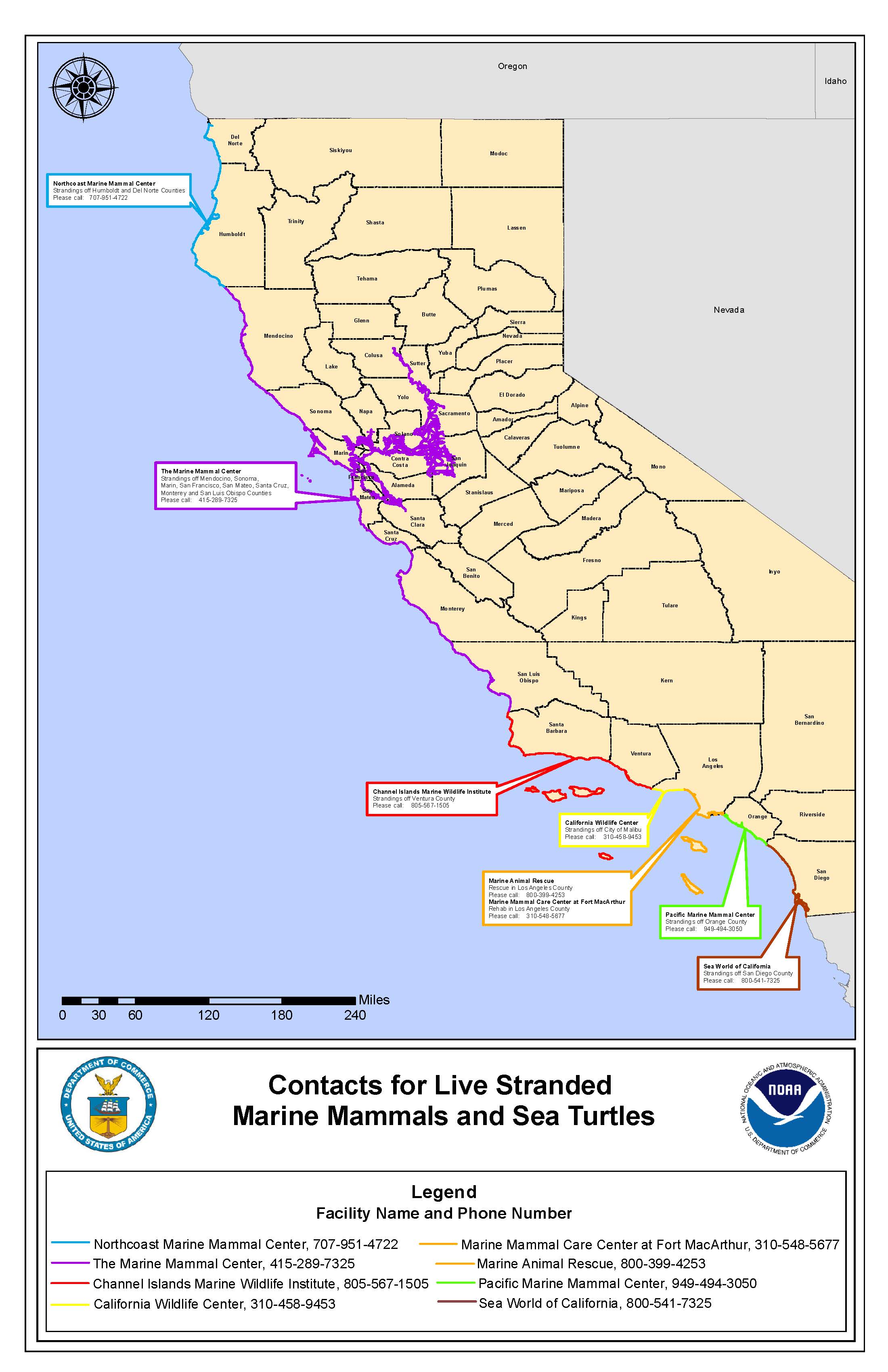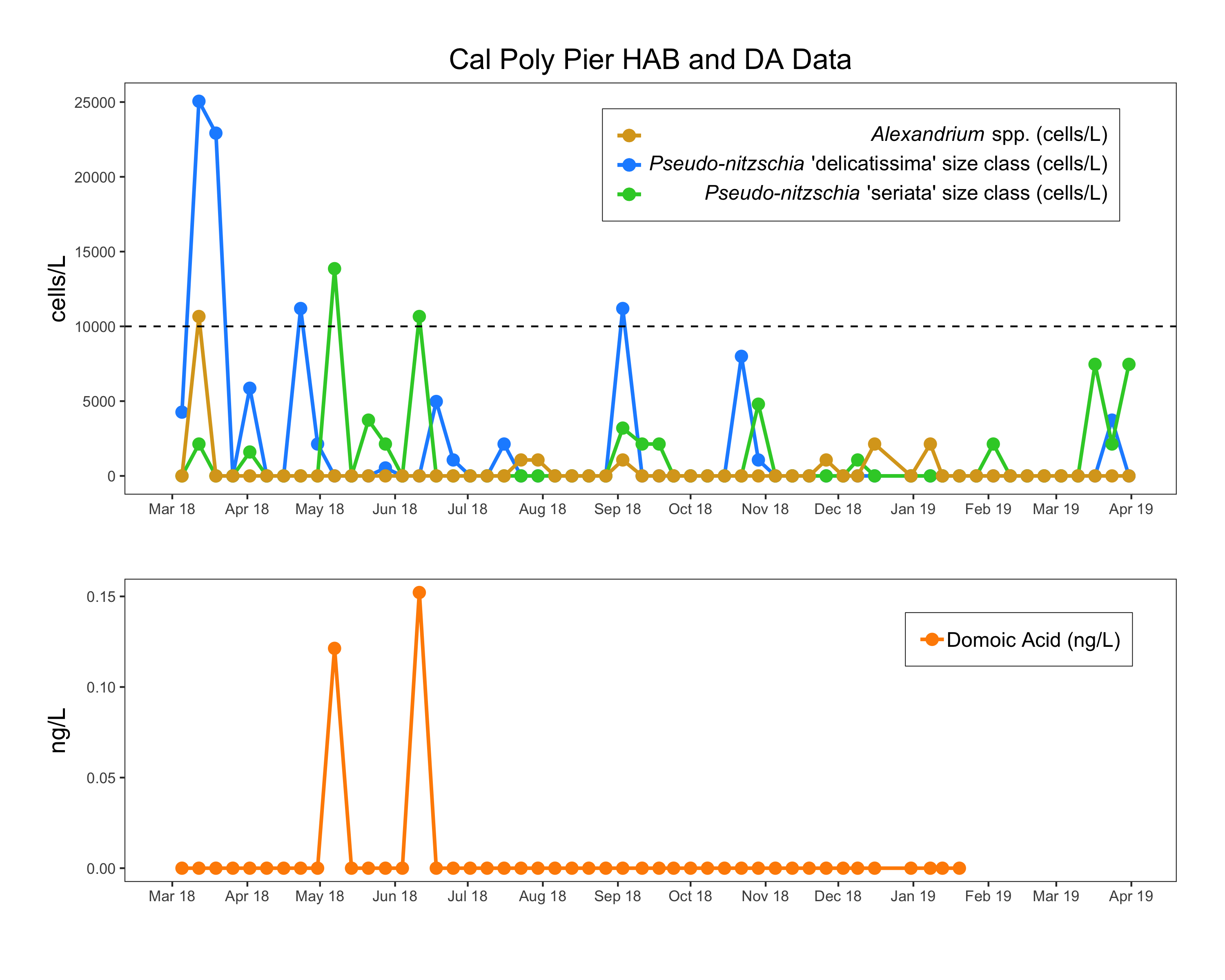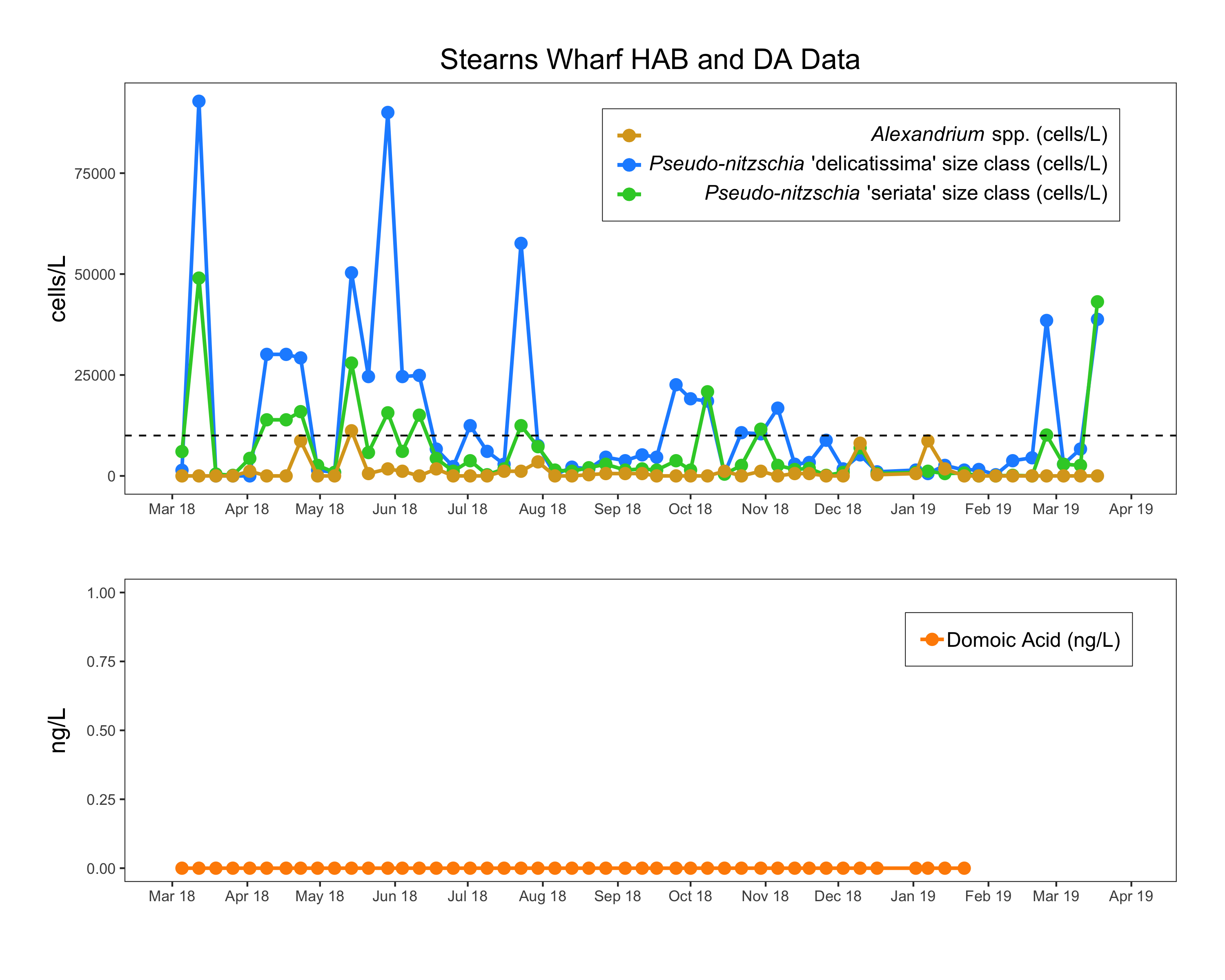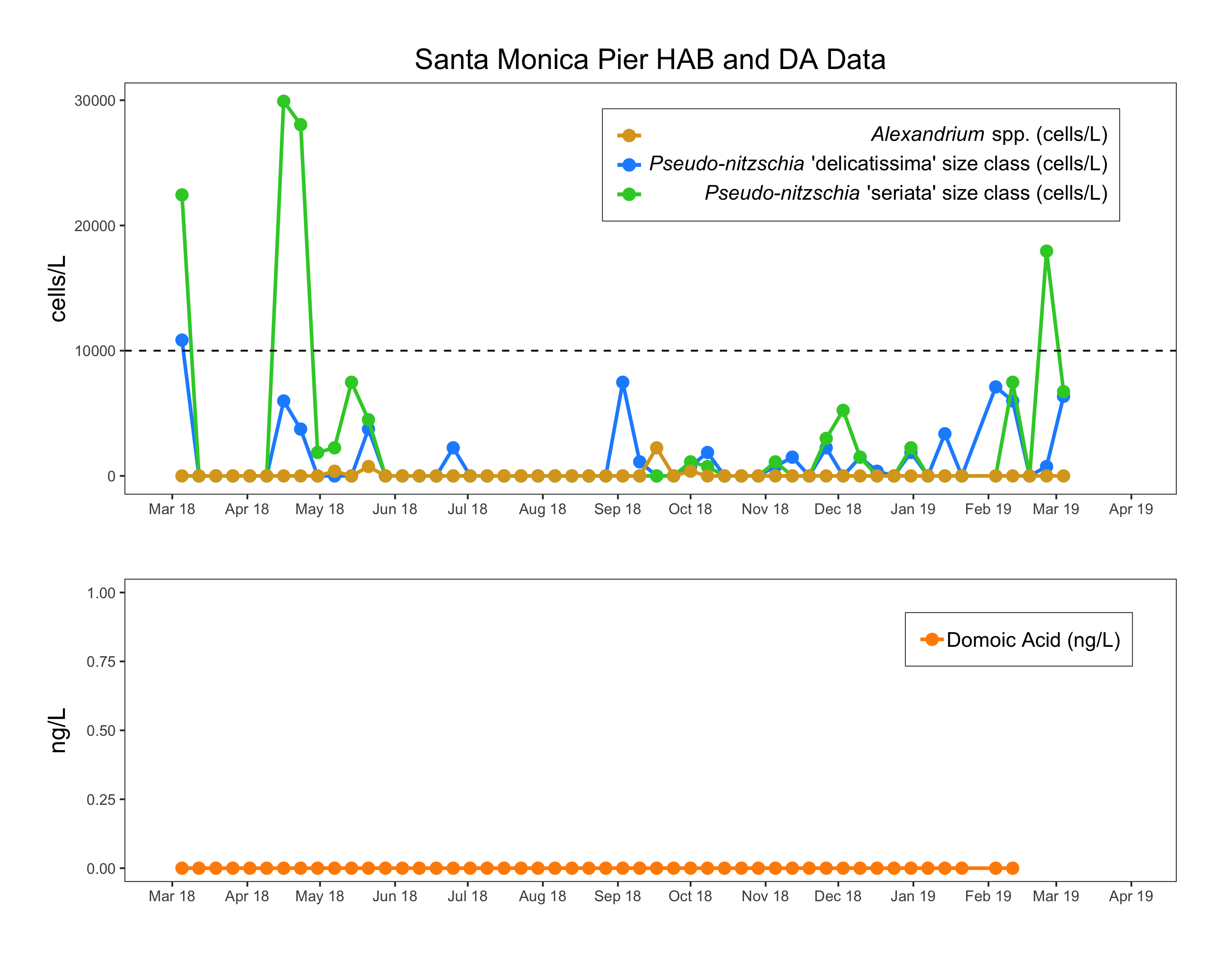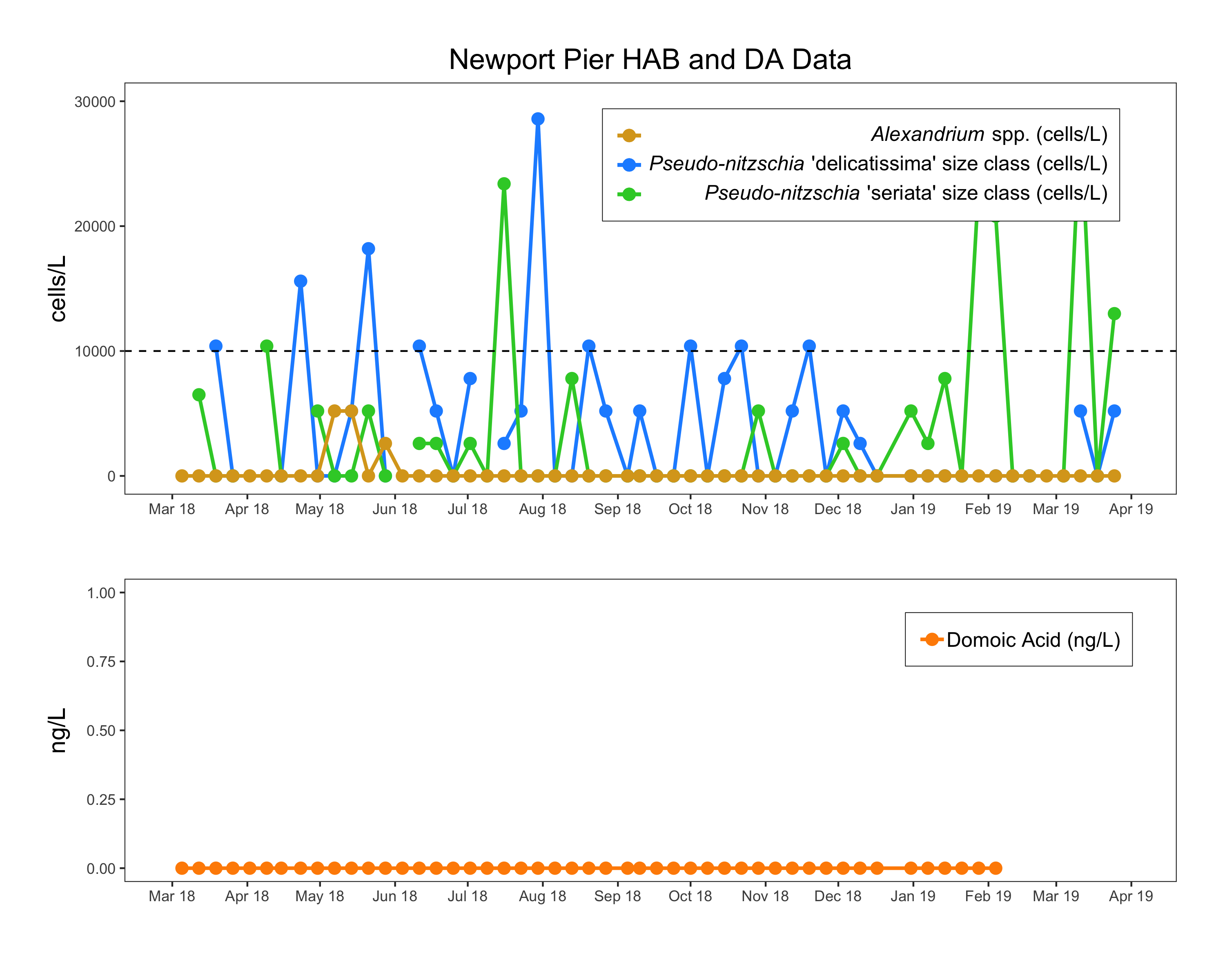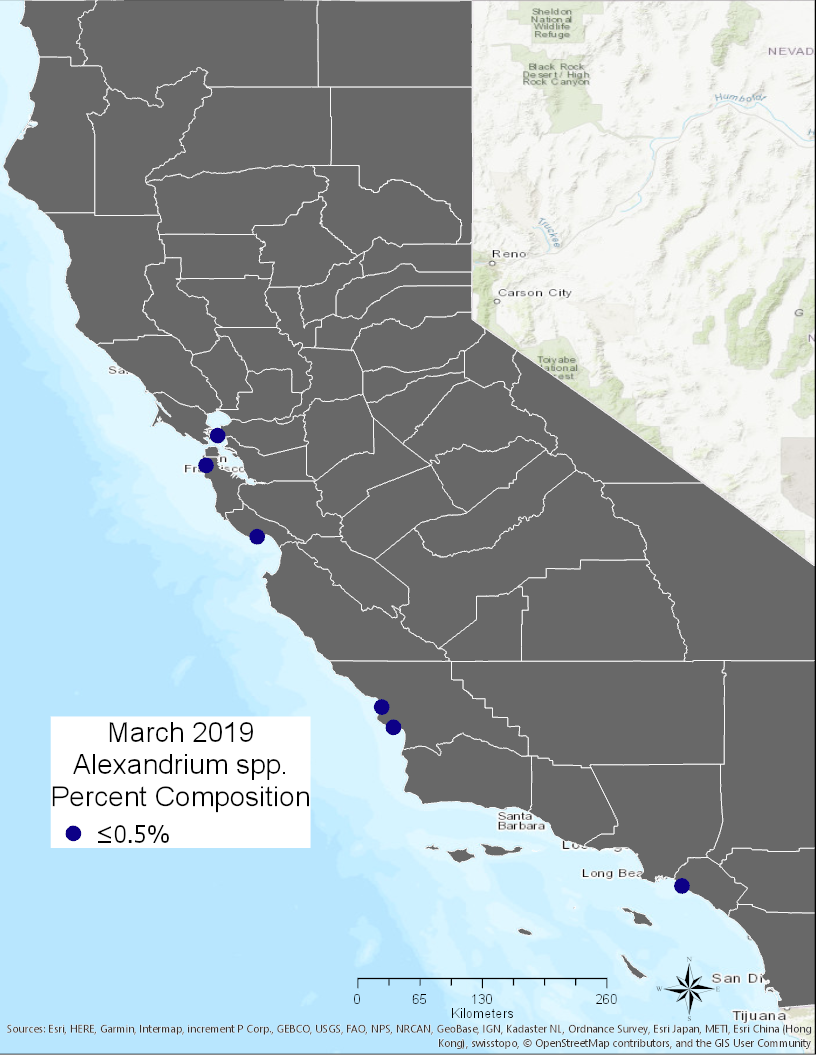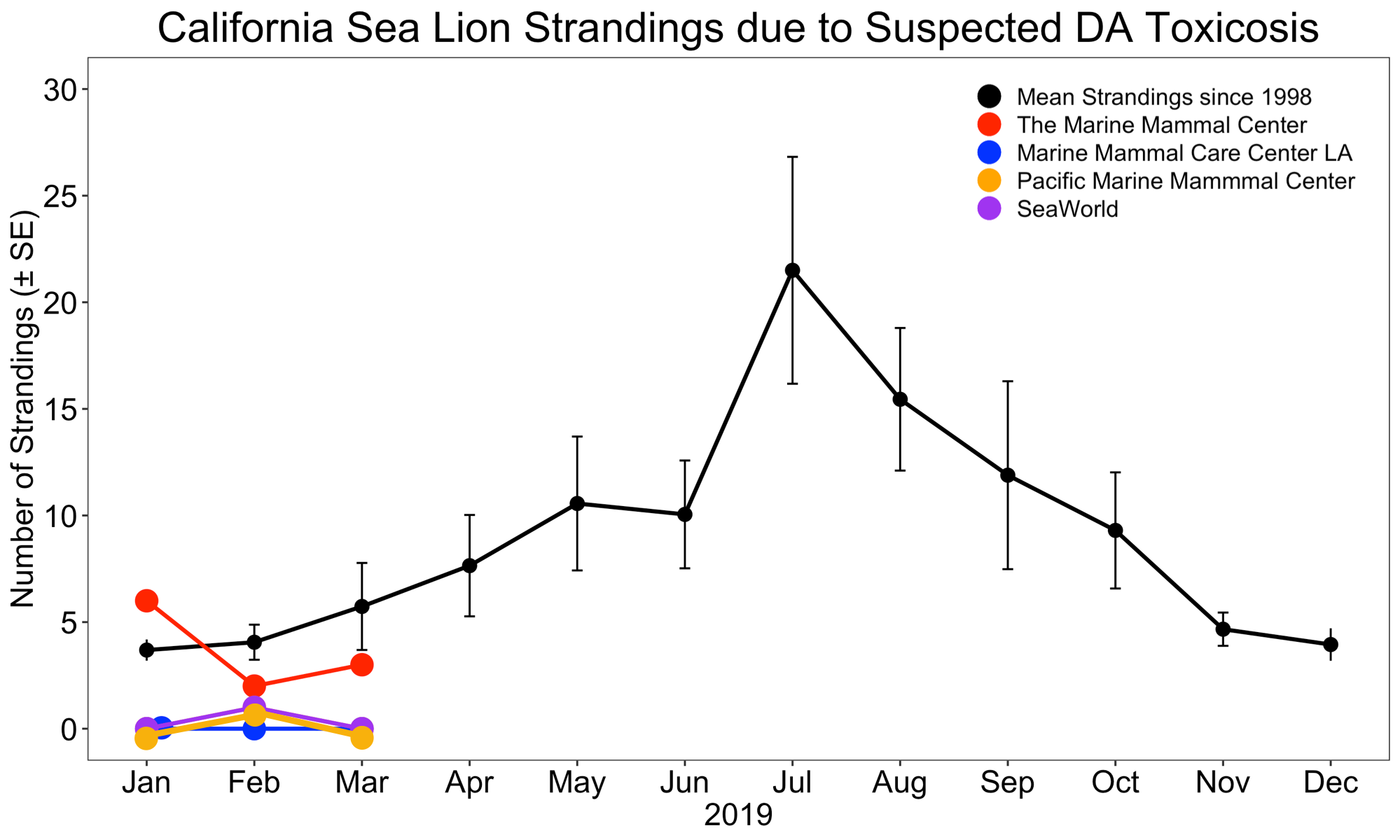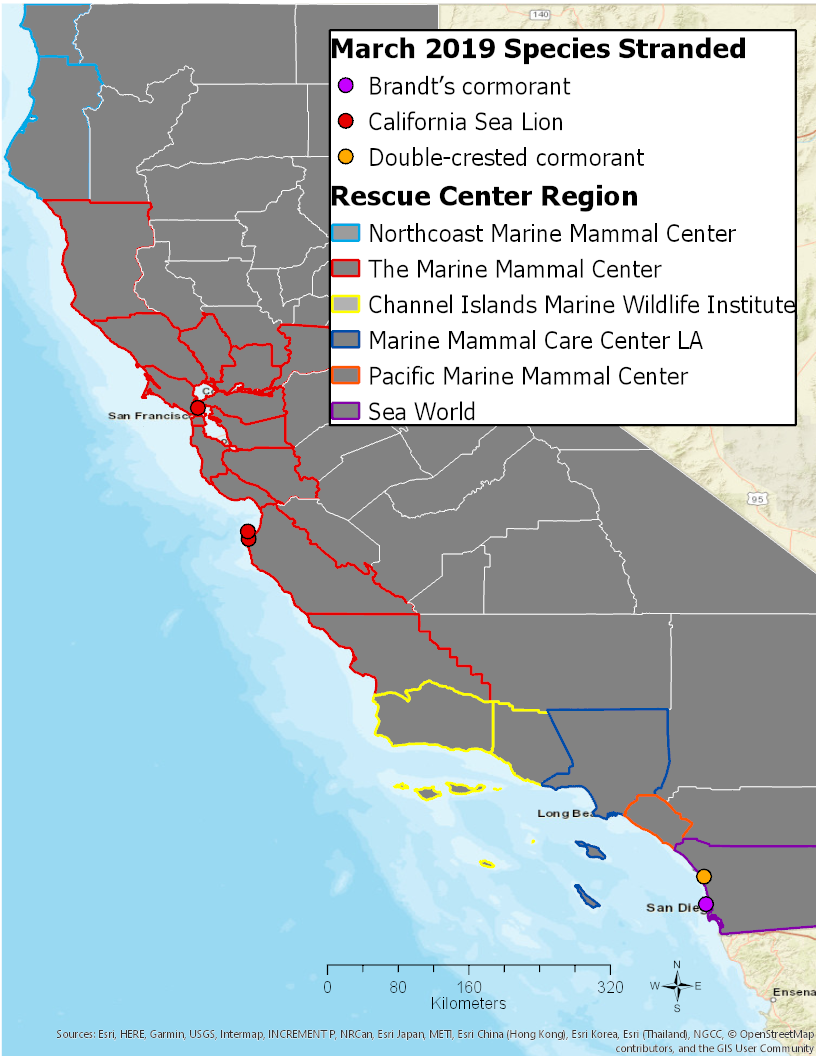Pseudo-nitzschia - C-HARM tells us where conditions are suitable for Pseudo-nitzschia spp. (all size classes) to grow well and where they might be more likely to produce domoic acid (DA). C-HARM probabilities for blooms in March are highest from the Santa Barbara Channel north, offshore to nearshore, with high nearshore probabilities in the Southern California Bight. The persistency of this pattern over the last several months suggests model re-tuning may be necessary. HABMAP observations of Pseudo-nitzschia spp. abundance indicate bloom conditions for both the "seriata" (toxigenic) and "delicatissima" (non-toxigenic) size-classes at stations in the Southern California Bight, i.e. from Stearns Wharf south, with intensity building as we move southward. However, records of Pseudo-nitzschia abundance were not yet available for the Santa Cruz Wharf or Scripps Pier. CDPH sampling in March shows highest Pseudo-nitzschia percent composition in the Southern Bight, Santa Barbara Channel, central coast, and Monterey Bay.
Domoic Acid - C-HARM also tells us where DA might be more likely to occur at high levels. March observations of DA from HABMAP sampling are only available for Santa Cruz Wharf so far, and those values indicate low DA activity in the northern Monterey Bay. Probabilities of particulate DA (pDA) are most pronounced in the nearshore regions of the North Coast, outside SF Bay, and in the Southern California Bight. High cellular DA probabilities in the Bight are consistent with the high rates of Pseudo-nitzschia growth in that area, where cDA production might also be peaking. Marine mammals strandings from DA toxicosis decreased in the Southern CA Bight from Feb to March but increased slightly in the central to northern region (SF Bay and southern Monterey Bay), consistent with high probabilities of pDA (and cDA) in those zones.
Alexandrium - HABMAP records for Alexandrium at pier sites show no activity from January to March 2019, which is consistent with little or no increases in the relative abundance of this dinoflagellate as measured by the CDPH volunteer phytoplankton monitoring network.
HABMAP Monitoring Sites
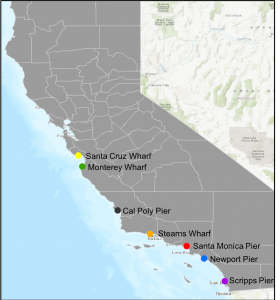
Note that data for some stations are not shown because they are not yet recorded in the public HABMAP archive.
Differentiating Pseudo-nitzschia species by light microscopy is difficult. For this reason, Pseudo-nitzschia "seriata" does not refer to an actual species but rather the larger size class of Pseudo-nitzschia, which is generally a more toxigenic group of species. Alternatively, Pseudo-nitzschia "delicatissima" refers to the smaller size class that is generally non-toxigenic. The dashed line on the plots demarcates the 10,000 cells/L "bloom" threshold designated here for Pseudo-nitzschia populations only.
Santa Cruz Wharf
Santa Cruz Municipal Wharf Pseudo-nitzschia spp., Alexandrium spp., and domoic acid results are not yet available for the month of March 2019.
Cal Poly Pier
Water samples were collected at Cal Poly Pier five times in the month of March. Pseudo-nitzschia delicatissima group and Pseudo-nitzschia seriata group were detected below bloom levels and Alexandrium spp. were not detected in any of the samples. Domoic Acid results are not yet available for the month of March 2019.
Stearns Wharf
Water samples were collected at Stearns Wharf three times in the month of March. Pseudo-nitzschia delicatissima group and Pseudo-nitzschia seriata group were detected above bloom levels and Alexandrium spp. were not detected in any of the samples. Domoic Acid results are not yet available for the month of March 2019.
Santa Monica Pier
Santa Monica Pier Pseudo-nitzschia spp., Alexandrium spp., and domoic acid results are not yet available for the month of March 2019.
Newport Beach Pier
Water samples were collected at Newport Beach Pier four times in the month of March. Pseudo-nitzschia delicatissima group and Pseudo-nitzschia seriata group were detected above bloom levels and Alexandrium spp. were not detected in any of the samples. Domoic Acid results are not yet available for the month of March 2019.
Scripps Pier
Scripps Pier Pseudo-nitzschia spp., Alexandrium spp., and domoic acid results are not yet available at this time.
CDPH observations for Pseudo-nitzschia spp. and Alexandrium spp.
From 1-31 March 2019, water samples were collected by volunteers and sent to the California Department of Public Health (CDPH) for analysis. Pseudo-nitzschia spp. were detected in 39 of the 46 samples. Pseudo-nitzschia spp. was recorded at Common density levels in nine of the samples including on March 20th at Point Pinos (27% composition), March 22nd at San Clemente Pier (20% composition). and March 17th at Capitola Pier (17%). Alexandrium spp. were detected in low levels (<0.5% composition) in all six samples in the month of March. You can also view CDPH weekly map layers of Pseudo-nitzschia and Alexandrium here.
The California Department of Fish and Wildlife (CDFW) issued no health advisories due to domoic acid in the month of February.
For the latest closures and updates, please visit the CDFW Health Advisories page. Data are provided by the California Department of Public Health, Environmental Management Branch.
Domoic acid (DA) is a potent neurotoxin produced by some diatom species of the genus Pseudo-nitzschia. Species exposed to DA can result in seizures, epilepsy, cardiomyopathy, and death depending upon the ingested dose. DA toxicosis commonly occurs in California Sea Lions (Zalophus Californianus), presumably due to a combination of foraging behavior and seasonal movements. The Marine Mammal Center (TMMC), the Marine Mammal Care Center Los Angeles (MMCC-LA), the Pacific Marine Mammal Center (PMMC), and SeaWorld act like an emergency room by working to rescue and rehabilitate sick and injured marine mammals, seabirds, and sea turtles.
The Marine Mammal Center and SeaWorld recorded a total of 3 marine mammals and 2 seabirds strandings presented with symptoms of domoic acid toxicosis in the month of March.
No DA toxicosis cases have been reported by the Marine Mammal Care Center Los Angeles or The Pacific Marine Mammal Center in March 2019.
February marine mammal and seabird strandings suspected due to DA toxicosis occurred at the following locations:
- March 7th, 2019 - California Sea Lion stranded at Pescadero Canyon, Carmel Beach, Monterey County - TMMC
- March 11th, 2019 - California Sea Lion stranded at Point Pinos, Pacific Grove, Monterey County - TMMC
- March 16th, 2019 - Double-crested Cormorant, Carlsbad, San Diego County - SeaWorld
- March 18th, 2019 - California Sea Lion stranded at Kell Cove, Rocks Beach, Marin County - TMMC
- March 28th, 2019 - Brandt’s Cormorant, La Jolla, San Diego County - SeaWorld
Who to call if you find a LIVE stranded marine mammal or sea turtle
Sea World of California (800) 541-7325
- San Diego County
Pacific Marine Mammal Center (949) 494-3050
- Orange County
Marine Animal Rescue (800) 399-4253 and California Wildlife Center (310) 458-9453
- Los Angeles County
Channel Islands Marine Wildlife Institute (805) 567-1505
- Santa Barbara County
- Ventura County
The Marine Mammal Center (415) 289-7325
- Alameda County
- Contra Costa County
- Marin County
- Mendocino County
- Monterey County
- Napa County
- Sacramento County
- San Francisco County
- San Luis Obispo
- San Mateo County
- Santa Cruz County
- Sonoma County
Northcoast Marine Mammal Center (707) 951-4722
- Del Norte County
- Humboldt County
